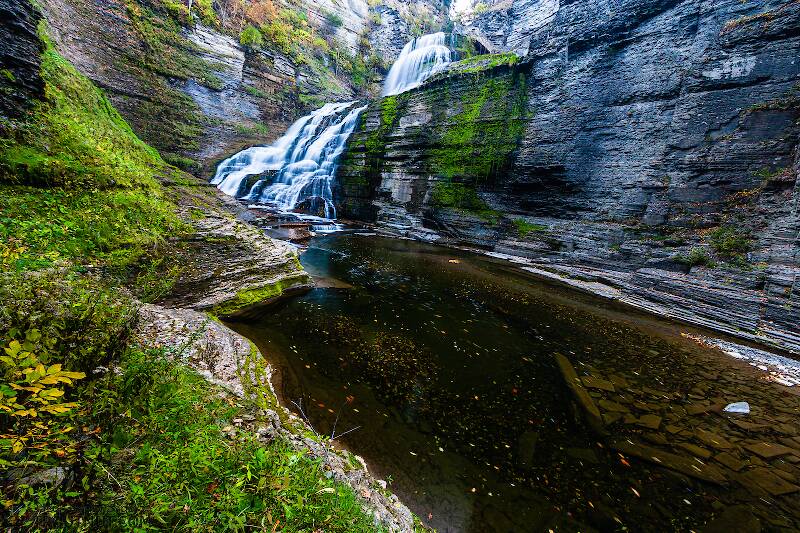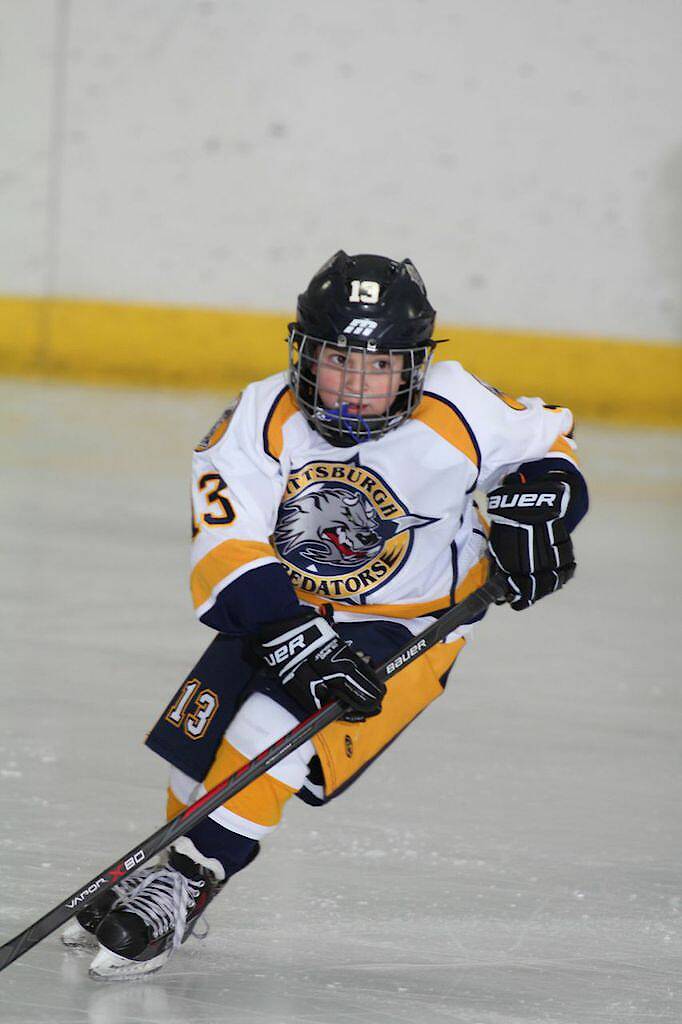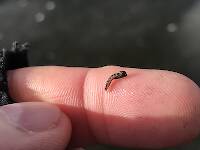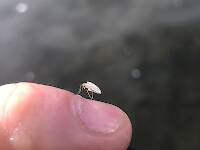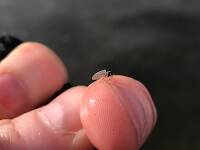
Hex Mayflies
Hexagenia limbata
The famous nocturnal Hex hatch of the Midwest (and a few other lucky locations) stirs to the surface mythically large brown trout that only touch streamers for the rest of the year.
Featured on the forum

I caught this tiny larva without a case, but it seems to key pretty clearly to to Glossosomatidae. From there, the lack of sclerites on the mesonotum points to either Glossosoma or Anagapetus. Although it's difficult to see in a 2D image from the microscope, it's pretty clear in the live 3D view that the pronotum is only excised about 1/3 of its length to accommodate the forecoxa, not 2/3, which points to Glossosoma at Couplet 5 of the Key to Genera of Glossosomatidae Larvae.

Troutnut is a project started in 2003 by salmonid ecologist Jason "Troutnut" Neuswanger to help anglers and
fly tyers unabashedly embrace the entomological side of the sport. Learn more about Troutnut or
support the project for an enhanced experience here.
Lastchance on Jul 28, 2010July 28th, 2010, 3:48 am EDT
it just dawned on me that i'm not sure what colors to make the shuck on various color midges. Would you agree with these colors?
Olive Midge: olive shuck
Brown Midge: brown shuck
grey midge: ?
black midge: ?
tan midge: ?
Olive Midge: olive shuck
Brown Midge: brown shuck
grey midge: ?
black midge: ?
tan midge: ?
Oldredbarn on Jul 29, 2010July 29th, 2010, 10:19 am EDT
Bruce,
I don't see anyone lining up here to help you with this one and I'm not at all surprised. Midging can be maddening! It can also be a blast when it works...My primarily positive experiences with midges have been in stillwater situations and my luck with them on the river not so good. I have one great river memory with midges and it was on Armstrongs Spring Creek at 6:00am in 1995.
I am going to make a couple suggestions and see what happens...Though it can be difficult I would do some homework and visit the places where you like to fish and leaving the rods at home, try and get an upclose and personal look at the critters in your stream. This is what you should be trying to imitate.
If you are just tying to tie (which is great) it don't matter so much and you can follow your pattern you mentioned and match the "shuck" to the color you are using for the adult part of the fly.
I do want you to explain to me what you may be referring to when you say shuck...What I mean is that to me the "gills" or filamentous ends of the pupa make more sense to imitate and sometimes people call these shucks...I have watched pond midges "hatch" and like our lovely mosquitoes they hang down under the surface tension and raise out the top like one of those slo-mo things you may remember from a growing bean in school or something and then stand for a moment on top of the water...The thing they are leaving behind I would think of as the shuck.
On the other hand I'm never really sure I understand what the hell a fish is "taking" or why and they will probably hit your imitaion, from-time-to-time, no matter what color the "shuck"...I think that trout see them all the time and will randomly pick off what looks real to them or behaves in a real manner.
Does this make sense? I know "pounding up" fish with midges sounds impossible, but they will suck in a Griffith's Nat and we can only guess what they are taking that for...The cluster thing sounds good to us, but can we be sure??? It just may look edible to them...A small beetle even...Who Knows?
We have had similar discussions here before and the little guys suck in nearly everything that floats by that looks close to food and then spits it right back out only to suck it in again. Go figure...
Spence
I don't see anyone lining up here to help you with this one and I'm not at all surprised. Midging can be maddening! It can also be a blast when it works...My primarily positive experiences with midges have been in stillwater situations and my luck with them on the river not so good. I have one great river memory with midges and it was on Armstrongs Spring Creek at 6:00am in 1995.
I am going to make a couple suggestions and see what happens...Though it can be difficult I would do some homework and visit the places where you like to fish and leaving the rods at home, try and get an upclose and personal look at the critters in your stream. This is what you should be trying to imitate.
If you are just tying to tie (which is great) it don't matter so much and you can follow your pattern you mentioned and match the "shuck" to the color you are using for the adult part of the fly.
I do want you to explain to me what you may be referring to when you say shuck...What I mean is that to me the "gills" or filamentous ends of the pupa make more sense to imitate and sometimes people call these shucks...I have watched pond midges "hatch" and like our lovely mosquitoes they hang down under the surface tension and raise out the top like one of those slo-mo things you may remember from a growing bean in school or something and then stand for a moment on top of the water...The thing they are leaving behind I would think of as the shuck.
On the other hand I'm never really sure I understand what the hell a fish is "taking" or why and they will probably hit your imitaion, from-time-to-time, no matter what color the "shuck"...I think that trout see them all the time and will randomly pick off what looks real to them or behaves in a real manner.
Does this make sense? I know "pounding up" fish with midges sounds impossible, but they will suck in a Griffith's Nat and we can only guess what they are taking that for...The cluster thing sounds good to us, but can we be sure??? It just may look edible to them...A small beetle even...Who Knows?
We have had similar discussions here before and the little guys suck in nearly everything that floats by that looks close to food and then spits it right back out only to suck it in again. Go figure...
Spence
"Even when my best efforts fail it's a satisfying challenge, and that, after all, is the essence of fly fishing." -Chauncy Lively
"Envy not the man who lives beside the river, but the man the river flows through." Joseph T Heywood
"Envy not the man who lives beside the river, but the man the river flows through." Joseph T Heywood
Lastchance on Jul 29, 2010July 29th, 2010, 2:04 pm EDT
Hi Spence: I've fished midge adults before and I've had a good time, although as you've said, it can be maddening. The fun for me is the challenge. I've been doing a lot of searching and reading since I made this post and my memory has been jogged. I swear my mind was blank as to how to approach shucks. I look at shucks as the case from which midges evolve. A.K. Best ties an emerger pattern with woodduck flank fibers as shucks--the markings give it a segmented appearance. Others seem to use grizzly hackle for the same purpose and still others use a few fibers of amber z-lon. Maybe I am wrong in thinking as those short filementous ends as shucks. I'll tell you what I'm going to do. I'm going to go with grizzly and woodduck fibers for the shucks and see what happens. I'll also tie a few with z-lon. I don't think it's really as important as I'm making it. I think if they're hungry, eating emergers and I fish them well, I'll fool a few. Thanks for jumping into the discussion. You've given me ideas to consider and that's what I was hoping to find.
The Best,
Bruce
The Best,
Bruce
Oldredbarn on Jul 29, 2010July 29th, 2010, 3:06 pm EDT
Bruce,
Think about tying up some small Klinkhammers...16 or 18 and do it all in black and some others in gray. Black body/ post of your choice and grizzly for the parachute hackle. Hansi ties them with a peacock thorax which is cool, but I sometimes tie the abdomen with a goose biot and dub the thorax...This fly of his was meant as an emerging caddis but it's a killer baetis fly even if I can no longer see them on the water. I use dark dun on the baetis version for the hackle...
On this pond I fish in early spring here I smack them silly with an all black Klinkhammer in size 16...The hardware boys on the beach watch me through binoculars and I will admit I ham it up a bit...They are hog stockies and even though they seem half dead to me they still make my Hardy scream! I've actually heard them on shore say, "That fly fisherman's in to another one." :)
I once had them waiting for me to float my bellyboat ashore and one guy asked me what I was using...I said midges which was met with a blank stare and I held up my rod so he could see the mosquito sized fly in my hook keeper...There was a long pause as he squinted at my fly and then he said, "I like to use corn."...Ok then.
Good luck!
Spence
Think about tying up some small Klinkhammers...16 or 18 and do it all in black and some others in gray. Black body/ post of your choice and grizzly for the parachute hackle. Hansi ties them with a peacock thorax which is cool, but I sometimes tie the abdomen with a goose biot and dub the thorax...This fly of his was meant as an emerging caddis but it's a killer baetis fly even if I can no longer see them on the water. I use dark dun on the baetis version for the hackle...
On this pond I fish in early spring here I smack them silly with an all black Klinkhammer in size 16...The hardware boys on the beach watch me through binoculars and I will admit I ham it up a bit...They are hog stockies and even though they seem half dead to me they still make my Hardy scream! I've actually heard them on shore say, "That fly fisherman's in to another one." :)
I once had them waiting for me to float my bellyboat ashore and one guy asked me what I was using...I said midges which was met with a blank stare and I held up my rod so he could see the mosquito sized fly in my hook keeper...There was a long pause as he squinted at my fly and then he said, "I like to use corn."...Ok then.
Good luck!
Spence
"Even when my best efforts fail it's a satisfying challenge, and that, after all, is the essence of fly fishing." -Chauncy Lively
"Envy not the man who lives beside the river, but the man the river flows through." Joseph T Heywood
"Envy not the man who lives beside the river, but the man the river flows through." Joseph T Heywood
Gutcutter on Jul 29, 2010July 29th, 2010, 3:14 pm EDT
bruce
i am a midge (and trico) addict. ok, so i admit it. there! now maybe jonathon can understand my small tippet affliction!(ha)
i tie and fish adults, emergers and pupae.
my best emerger pattern is very simple and effective.
the hook i use for this pattern is either a gamakatsu c-12bm (26,28) or tmc 2488 (24,30). 5-7 strands of light grey z-lon and a thread (tapered) abdomen with 2 small white cdc feathers tied in so the tips flare back over the abdomen- almost like an elkhair caddis. i tie these with grey, tan, olive and black thread. simple and deadly.
the adults are tied the same except with no tail and a single very small cdc puff.
the pupae are tied on standard dryfly hooks (daiichi 1110 in 22,24) and are utc ultrawire xs tapered abdomen and antron dubbing thorax picked out a bit.
i do best on the pupae at dusk and into the night - how the hell do they see it?
oh - and i don't shine a light!
tony
i am a midge (and trico) addict. ok, so i admit it. there! now maybe jonathon can understand my small tippet affliction!(ha)
i tie and fish adults, emergers and pupae.
my best emerger pattern is very simple and effective.
the hook i use for this pattern is either a gamakatsu c-12bm (26,28) or tmc 2488 (24,30). 5-7 strands of light grey z-lon and a thread (tapered) abdomen with 2 small white cdc feathers tied in so the tips flare back over the abdomen- almost like an elkhair caddis. i tie these with grey, tan, olive and black thread. simple and deadly.
the adults are tied the same except with no tail and a single very small cdc puff.
the pupae are tied on standard dryfly hooks (daiichi 1110 in 22,24) and are utc ultrawire xs tapered abdomen and antron dubbing thorax picked out a bit.
i do best on the pupae at dusk and into the night - how the hell do they see it?
oh - and i don't shine a light!
tony
All men who fish may in turn be divided into two parts: those who fish for trout and those who don't. Trout fishermen are a race apart: they are a dedicated crew- indolent, improvident, and quietly mad.
-Robert Traver, Trout Madness
-Robert Traver, Trout Madness
Oldredbarn on Jul 30, 2010July 30th, 2010, 5:57 am EDT
Tony,
I cut and pasted and printed a copy of your midge patterns here...I'm not sure why because, as I mentioned above, a size 18 baetis is getting to be impossible for me to see. I have these Marinaro hooks that Partridge put out years back and I bought some and they have been crying for use from the hook drawer ever since...
I know you are way busy, but sometime in the future, you should give us a thread on midge fishing for trout...I mentioned above that my river experiences with midge fishing in rivers hasn't been all that great...When I used to have a little more spare time myself in the early 90's I did do quite well with Tricos & my beloved & renamed P. anoka...
I used to subscribe to Trout & Salmon from England and midge fishing is big over there and they have a zillion buzzers and the like. I tied them like crazy only to find I've carried my midge boxes for years and the flies never get wet...Maybe you can reintroduce me to the minute before I go totally blind...
I have two wonderful 3wts and a 4wt that seldom see service any more...Somethings wrong here.
Spence
PS Has someone kidnapped Matt? Both he and Jason have fallen off the grid...I hope they are getting lucky somewhere...;)
I cut and pasted and printed a copy of your midge patterns here...I'm not sure why because, as I mentioned above, a size 18 baetis is getting to be impossible for me to see. I have these Marinaro hooks that Partridge put out years back and I bought some and they have been crying for use from the hook drawer ever since...
I know you are way busy, but sometime in the future, you should give us a thread on midge fishing for trout...I mentioned above that my river experiences with midge fishing in rivers hasn't been all that great...When I used to have a little more spare time myself in the early 90's I did do quite well with Tricos & my beloved & renamed P. anoka...
I used to subscribe to Trout & Salmon from England and midge fishing is big over there and they have a zillion buzzers and the like. I tied them like crazy only to find I've carried my midge boxes for years and the flies never get wet...Maybe you can reintroduce me to the minute before I go totally blind...
I have two wonderful 3wts and a 4wt that seldom see service any more...Somethings wrong here.
Spence
PS Has someone kidnapped Matt? Both he and Jason have fallen off the grid...I hope they are getting lucky somewhere...;)
"Even when my best efforts fail it's a satisfying challenge, and that, after all, is the essence of fly fishing." -Chauncy Lively
"Envy not the man who lives beside the river, but the man the river flows through." Joseph T Heywood
"Envy not the man who lives beside the river, but the man the river flows through." Joseph T Heywood
PaulRoberts on Aug 21, 2010August 21st, 2010, 1:47 am EDT
Most midges shucks I've paid attention to were gray -in hand. But at the surface film, which is bent as the midge pops through, they may be different. Check out this amazing video:
http://www.midcurrent.com/video/clips/cutter_midge.aspx
It shows midge shucks as very pale -translucent white with slightly darker ribbing. I bought some off-white antron and used a permanent marker for the ribbing. Getting rather anal, but I consider it aesthetic artwork as much as important to the fish.
http://www.midcurrent.com/video/clips/cutter_midge.aspx
It shows midge shucks as very pale -translucent white with slightly darker ribbing. I bought some off-white antron and used a permanent marker for the ribbing. Getting rather anal, but I consider it aesthetic artwork as much as important to the fish.
Lastchance on Aug 24, 2010August 24th, 2010, 1:55 am EDT
That's an amazing film. So what are we representing when tying short white fibers protruding from the head and from the tail area? Are those gills at the head? It seems as though a light dun antron would suffice as a shuck.
Bruce
Bruce
Oldredbarn on Aug 24, 2010August 24th, 2010, 2:45 am EDT
Paul,
That is a great video.
Bruce in England they are fond of fishing flies they call "buzzers" and that white tuft of antron they tie on either end of these flies represents "gills"...The part of their structure for breathing under water. You can see it in some of the larvae swiming to the surface in the video.
I use to subscribe to "Trout & Salmon" from England and they fish still waters like Lochs etc over there...It's quite a big deal with competitions etc...They do it from boats with "droges" (sp?) that are like little sails underwater that controls their drift.
I really enjoy stillwater fishing for trout, but we have few places here in Michigan to pull this off. This is one reason I've found it difficult to avoid the stocked pond in the spring near here...Even when I can barely stand looking at the poor hatchery fish that they stock in it.
I have watched some midges emerging like that on the pond from my float tube. It reminds me of those old slow-mo/time lapse things of a bean pod growing.
Cool stuff Paul! Thanks!
Spence
That is a great video.
Bruce in England they are fond of fishing flies they call "buzzers" and that white tuft of antron they tie on either end of these flies represents "gills"...The part of their structure for breathing under water. You can see it in some of the larvae swiming to the surface in the video.
I use to subscribe to "Trout & Salmon" from England and they fish still waters like Lochs etc over there...It's quite a big deal with competitions etc...They do it from boats with "droges" (sp?) that are like little sails underwater that controls their drift.
I really enjoy stillwater fishing for trout, but we have few places here in Michigan to pull this off. This is one reason I've found it difficult to avoid the stocked pond in the spring near here...Even when I can barely stand looking at the poor hatchery fish that they stock in it.
I have watched some midges emerging like that on the pond from my float tube. It reminds me of those old slow-mo/time lapse things of a bean pod growing.
Cool stuff Paul! Thanks!
Spence
"Even when my best efforts fail it's a satisfying challenge, and that, after all, is the essence of fly fishing." -Chauncy Lively
"Envy not the man who lives beside the river, but the man the river flows through." Joseph T Heywood
"Envy not the man who lives beside the river, but the man the river flows through." Joseph T Heywood
Martinlf on Jan 12, 2015January 12th, 2015, 3:14 pm EST
Gutcutter has some good midge patterns in this thread
"He spread them a yard and a half. 'And every one that got away is this big.'"
--Fred Chappell
--Fred Chappell
Quick Reply
Related Discussions
Topic
Replies
Last Reply
1
Mar 9, 2012
by Wiflyfisher
by Wiflyfisher
4
Sep 4, 2012
by Entoman
by Entoman

